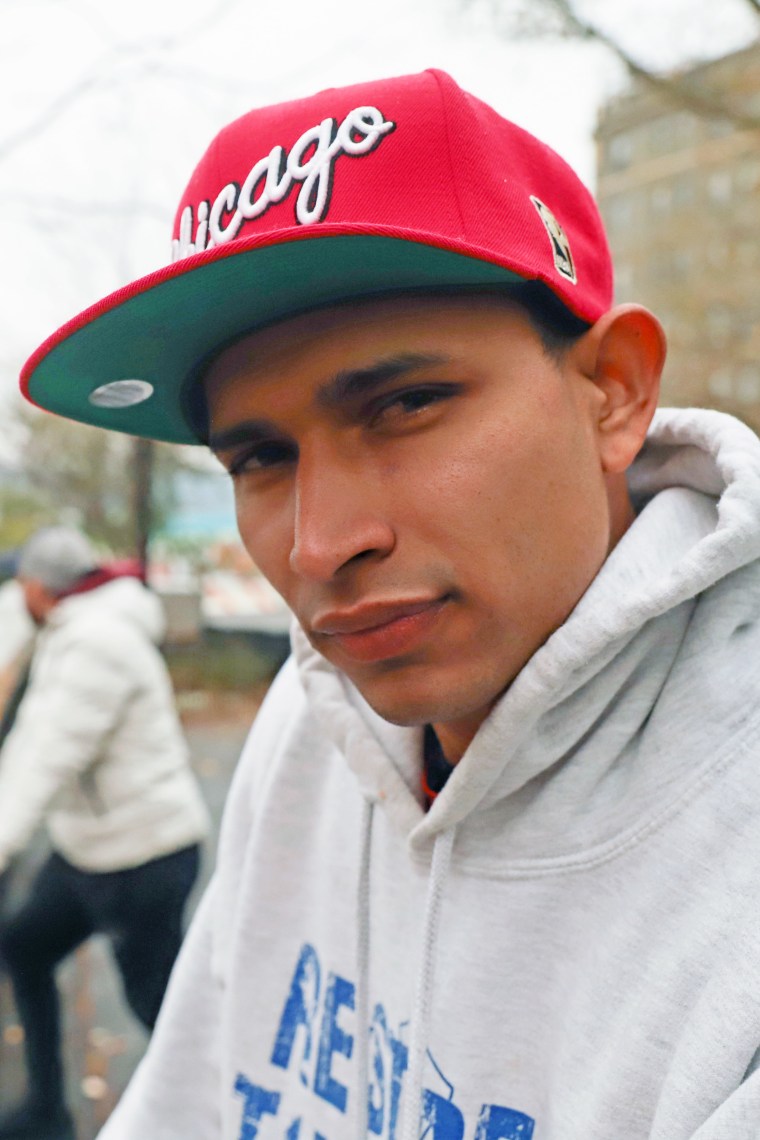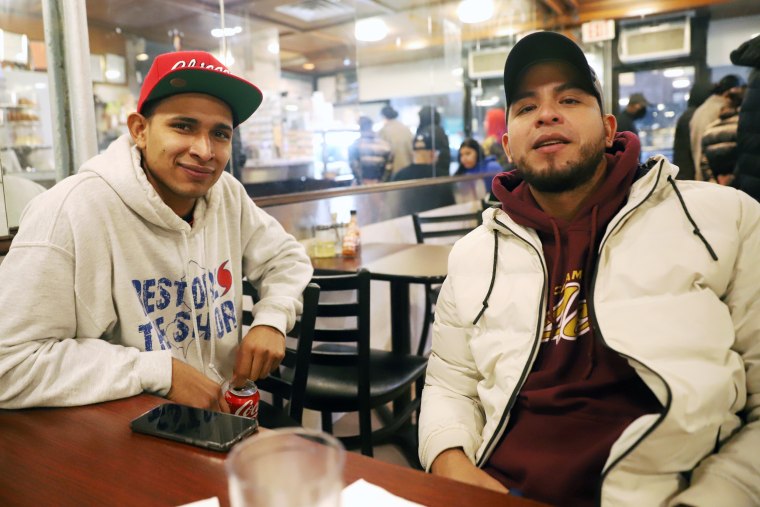After Tonny Tavera and Carlos Niño walked across the U.S. border into El Paso in late September 2022, immigration officials gave them the option to board a bus to either New York or Chicago, they recalled.
Niño chose New York, because he’d seen it depicted in movies growing up.
“Those screens — let’s go there,” he said he told Tavera, referring to the giant video billboards that line Times Square.
A few days later, Tavera and Niño were among the approximately 104,000 migrants, asylum-seekers and refugees who have arrived in New York City since the spring of 2022. As they and others from around the world adjust to their new lives, city officials and immigrant advocates are trying to manage the city’s commitment to house everyone who arrives while dealing with increasingly limited resources.
Both men shared their stories in Spanish over the course of 10 months after they arrived in New York.

Tavera, 35, said he left Caracas after having been the victim of a late-night attack by people he believed were associated with a former employer, a government-run commodities company. Niño, 30, left the small city of San Cristóbal after Venezuela’s president required people to re-enlist in the military. Niño said he’d already completed a tour of duty and didn’t want to return “al gusto del presidente” — at the president’s will, he said.
The friends are two of the approximately 7 million Venezuelans who have left their country since the early 2010s, fleeing its economic and political crisis.
They met in Colombia, where they eventually decided to come to the U.S. along with a small group of other Venezuelans hoping to find better economic opportunities than in Latin America. After they crossed the treacherous Darien Gap between the border of Colombia and Panama, their group separated.
They later found out one of their friends drowned trying to cross the Rio Grande to get to Texas. His death devastated them, but they decided to continue their trip.
Because the two men didn’t have existing connections when they arrived in New York, they landed in the city’s shelter system.
A large proportion of them have come through the border in Texas, where Gov. Greg Abbott began sending people by bus to New York and other Democratic-run cities last summer. Though some migrants reported having come voluntarily, others said they’ve been denied the choice. New York Mayor Eric Adams has criticized Abbott’s actions as inhumane, saying they were done without coordination, while Abbott has repeatedly defended his decision.
The arrivals come during a widespread housing crisis in the city, where the number of people in city shelters each night has surpassed 80,000. Since 1981, New York City has been legally required to shelter every person in need.
Adams has been seeking changes to that requirement and meanwhile has asked for more federal support in an escalating back-and-forth with federal and state officials over who should be responsible for managing the growing number of people in need of housing, medical and financial assistance upon arrival. Both Adams and New York Gov. Kathy Hochul have also been calling for expedited work permits for asylum-seekers.
Trying to find their way
Niño and Tavera haven’t kept close track of the groups and offices they’ve worked with to find housing and support. Their journeys have overlapped with the city’s broader efforts to assist others in their position.

Soon after he arrived, Niño found himself at a shelter on Randall’s Island, an isolated expanse of athletic fields dotted with other shelters and psychiatric facilities. Nearby, the city had set up an emergency tent shelter to house other recently arrived migrants. It was removed after arrivals decreased in the fall, but officials announced the opening of a similar facility on the island early last month. Niño was later transferred to a different shelter in the Bronx.
Tavera landed in a city shelter in Brooklyn, where he stayed for several weeks before he was assigned a spot in a decommissioned hotel in upper Manhattan. Both he and Niño spent the next few months waiting for work authorization, keeping in regular contact with each other and with friends and family in Latin America.
Tavera said a contact he made in the city government — he didn’t remember which office — helped him find space in a shared apartment in Brooklyn in January. He moved in with two other Venezuelans and a Colombian, and he said the city government assists with rent payments. In March, he worked with a private employment agency to secure work at a Brooklyn-based construction company, where, he said, he was helping with electrical installations and clearing construction debris from job sites.
For Niño, the adjustment has been less stable. He hasn’t yet left the shelter system, and he is staying in the same facility in the Bronx he has been in for months. Finding steady employment has also been difficult — he said he has been able to find temporary jobs and gigs but nothing permanent.
“Sometimes it’s two or three days a week,” he wrote over Facebook Messenger. “But it’s not all the time and I don’t know where to go to find work.”
Both have expressed their appreciation for the support they’ve received from city authorities. They also have said they would return to Venezuela if the situation improved, though neither has much confidence that it will.
Providing a ‘rapid response’
Some residents have pushed back against the city’s efforts to provide shelter for migrants who have just arrived. A new temporary housing facility in Queens last month was met with protests from residents who said the location wasn’t appropriate. A proposal to house several hundred migrants in a former school on Staten Island also sparked a protest from neighborhood residents, which included brief scuffles between people in support of and against the decision. A judge signed a temporary order blocking that facility from opening until a hearing scheduled for Wednesday.
Manuel Castro, the commissioner of the Mayor’s Office of Immigrant Affairs, believes the protests represented an intentional effort to spark fear and anti-immigrant sentiments in the city.
“It’s clear that it’s a concerted effort, not just by Gov. Abbott, but these folks who want to politicize the situation, divide people and, frankly, use these for their political purposes,” he said in an interview Thursday. “And what I’ve been saying to all New Yorkers is let’s not fall for that trap.”
Meanwhile, immigrant rights groups have expanded their capacity to support those who are arriving. Murad Awawdeh, the executive director of the New York Immigration Coalition, which represents around 200 organizations across the state, said in an interview that groups have been operating in “rapid response mode” over the past few years, expanding their educational programs and services with the same resources they had before.
“Our organization itself doubled and tripled our capacity — every organization, part of our membership, has done the same, with little to no support,” he said.
Awawdeh said his coalition has been advocating to make it easier for people to meet the city’s housing requirements, including reducing the criteria families must meet before they leave the shelter system, changing rules for child care to allow parents to find work more easily, and finding permanent housing for migrants who have been in the shelter system for a long time — sometimes multiple years.
In general, he hopes the arrivals can help create an opportunity to fix deeper-seated housing issues that have plagued the city over the years. He noted that the Adams administration inherited a shelter system at the beginning of 2022 that was already overburdened, with 50,000 people in public shelters and another 50,000 in private shelters. “The shelter system just never worked — it has not worked for decades,” Awawdeh said.
He echoed city officials’ calls for more federal action, not only in the form of financial support but also in the form of legal accommodations for recent migrants and a reduction of Covid-related backlogs in immigration cases, and he called for comprehensive immigration reform.
Tavera said that for now, he plans to apply for asylum in the U.S. but hasn’t started the process — he has been asking around for an immigration lawyer, who he hopes can provide clarity about the necessary steps. He’s not sure that what direction his case will go in once he does, but he knows it’s ultimately out of his control. “If it’s [meant] for me, I’m going to get it,” he said.
Niño hasn’t decided about the timing for his asylum application, either. For now, he said, he may move to New Jersey, though he’s not yet sure how or when.
